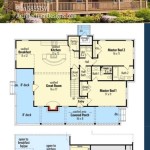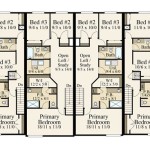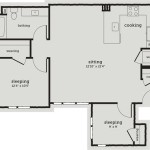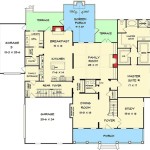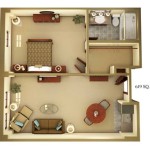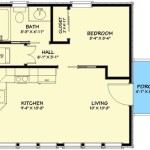Single Story Waterfront House Plans: Designing for Seamless Coastal Living
Waterfront living presents a unique opportunity to connect with nature and enjoy breathtaking views. Single-story waterfront house plans are particularly appealing as they offer accessibility, convenience, and an unobstructed connection to the surrounding environment. These plans prioritize horizontal living, blurring the lines between indoor and outdoor spaces and maximizing the scenic advantages of a coastal property. This article explores the key considerations, common design elements, and advantages of choosing a single-story layout for a waterfront home.
The appeal of a single-story waterfront home lies in its simplicity and functionality. By eliminating stairs, these designs cater to individuals of all ages and mobility levels. The horizontal orientation also lends itself well to maximizing views and natural light penetration. Furthermore, single-story layouts often simplify construction and maintenance, making them a practical and aesthetically pleasing choice for coastal properties.
Optimizing Views and Natural Light
One of the primary goals of any waterfront home design is to capitalize on the available views. For single-story plans, this often involves strategically placing large windows, sliding glass doors, and strategically positioned skylights. The orientation of the house on the property is crucial. Generally, the main living areas, such as the living room, dining room, and master bedroom, are positioned to face the water, ensuring panoramic vistas and abundant natural light. The placement of windows should also consider the direction of sunlight throughout the day to mitigate glare and heat gain. Overhangs and strategically placed landscaping can provide shade during peak sunlight hours, enhancing comfort and energy efficiency.
The design should also incorporate outdoor living spaces, such as decks, patios, and screened porches, which extend the living area and provide opportunities to enjoy the waterfront setting. These outdoor spaces can be seamlessly integrated with the interior through large sliding glass doors or bi-fold doors, creating a smooth transition between indoors and outdoors. The careful selection of materials, such as durable and weather-resistant decking and furniture, is essential for maintaining the beauty and functionality of these outdoor areas.
Furthermore, the use of reflective surfaces, such as light-colored paint and polished flooring, can help to amplify natural light and create a brighter and more inviting interior space. The strategic placement of mirrors can also enhance the sense of spaciousness and reflect the surrounding waterfront scenery. Thoughtful landscaping, including native plants and trees, can frame the views and create a sense of privacy while preserving the natural beauty of the coastal environment.
Addressing Coastal Environmental Factors
Building a waterfront home requires careful consideration of the unique environmental challenges posed by coastal locations. These challenges include exposure to saltwater, high winds, storm surges, and potential flooding. Therefore, the design and construction of a single-story waterfront home must prioritize durability and resilience.
The foundation is a critical aspect of the design, and it must be engineered to withstand the forces of nature. Elevated foundations, such as pilings or piers, are often used in flood-prone areas to raise the living space above the predicted flood level. This not only protects the house from water damage but also allows for better ventilation beneath the structure, reducing the risk of moisture accumulation and mold growth.
The choice of building materials is equally important. Materials that are resistant to saltwater corrosion and decay, such as pressure-treated lumber, fiberglass, and stainless steel, are essential for ensuring the long-term durability of the home. Roofing materials should be chosen for their wind resistance and ability to withstand harsh weather conditions. Impact-resistant windows and doors are also crucial for protecting the home from flying debris during storms. The exterior cladding should be selected not only for its aesthetic appeal but also for its ability to withstand the elements and minimize maintenance.
In addition to the structural aspects of the home, it's also important to consider the landscape design. Stormwater management is a crucial aspect of coastal development, and the landscaping should be designed to minimize runoff and prevent erosion. The use of native plants can help to stabilize the soil and provide natural habitat for wildlife. Shoreline stabilization measures, such as bulkheads or riprap, may also be necessary to protect the property from erosion.
Prioritizing Accessibility and Functionality
One of the key advantages of single-story waterfront house plans is their inherent accessibility. The absence of stairs makes the home easily navigable for individuals of all ages and abilities. This is particularly important for homeowners who plan to age in place or who have family members with mobility limitations.
The design should incorporate wide doorways and hallways to accommodate wheelchairs and walkers. Level thresholds between rooms and outdoor spaces are also essential for creating a barrier-free environment. Bathrooms should be designed with grab bars and accessible fixtures to ensure safety and independence. Kitchens should be designed with adjustable-height countertops and accessible appliances to accommodate users of different heights and abilities.
Beyond accessibility, functionality is another important consideration. The layout of the home should be designed to maximize efficiency and convenience. The kitchen should be located near the dining area and the outdoor entertaining spaces to facilitate meal preparation and serving. The laundry room should be located near the bedrooms to minimize the distance for carrying laundry. Storage space should be ample and strategically located throughout the house to keep clutter at bay.
The open floor plan is a popular choice for single-story waterfront homes, as it creates a sense of spaciousness and allows for easy flow between rooms. This type of layout is particularly well-suited for entertaining and allows for unobstructed views of the waterfront. However, it's important to consider the acoustics of an open floor plan and to incorporate sound-absorbing materials to minimize noise transmission. The furniture layout should be carefully planned to define different functional zones within the open space.
In summary, single-story waterfront house plans offer a compelling combination of aesthetics, functionality, and accessibility. By carefully considering the unique challenges and opportunities presented by coastal locations and tailoring the design to meet the specific needs and preferences of the homeowner, it is possible to create a beautiful and sustainable home that seamlessly integrates with the surrounding environment.
The selection of a suitable architectural style should also align with the coastal surroundings. Styles such as coastal contemporary, craftsman, or traditional beach house designs often complement the natural setting. The exterior color palette should harmonize with the landscape, incorporating natural tones and materials to create a cohesive and visually appealing aesthetic. Furthermore, the integration of sustainable design principles, such as solar panels, rainwater harvesting systems, and energy-efficient appliances, can minimize the environmental impact of the home and reduce operating costs.

Waterfront House Plans All Styles Of Home Floor

Lake House Plans Waterfront Monster

Mediterranean House Plan 1 Story Tuscan Style Waterfront Floor

Waterfront House Plans All Styles Of Home Floor

Waterfront House Plans The Plan

Lake House Plans Waterfront Home Designs

House Plan 173 Waterfront Cove

Lake House Plans Waterfront Home Designs

1 Story Beach Lake Style House Plan With Wraparound Covered

Beach House Plan Transitional West Indies Caribbean Style Floor

